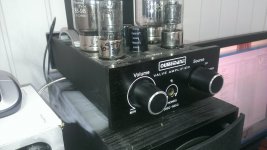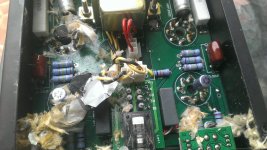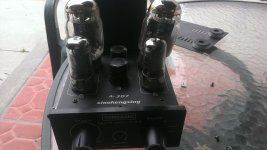I was moving some equipment home so I could use the EZ10 (6V6 PP) amps that I built and replace them with a Chinese single ended amp. I had pretty good luck with this one but its life came to an abrupt end yesterday. It was buried shortly after with a dignified send off.
It had been in use daily for about 1year, then I built a couple 6V6 monoblock amps (EZ10) to replace the Chinese amp with.
Well after about 3 months of operations I decided I wanted to take my GOOD amps home and put back into service the Chinese single ended amp. This created the Big Bang and some stinky smoke.
It seems that the amp had no fuses and the one of the PIO caps that blew was placed very close and parallel to a HOT resistor, which also got destroyed by the shock of the explosion (see second pic).
Pictures for your enjoyment, picture 1 is smoke pouring out after the blow up, then the guts and finally a picture of the amp.
Happy Friday, out with a bang 😀
Sandy
It had been in use daily for about 1year, then I built a couple 6V6 monoblock amps (EZ10) to replace the Chinese amp with.
Well after about 3 months of operations I decided I wanted to take my GOOD amps home and put back into service the Chinese single ended amp. This created the Big Bang and some stinky smoke.
It seems that the amp had no fuses and the one of the PIO caps that blew was placed very close and parallel to a HOT resistor, which also got destroyed by the shock of the explosion (see second pic).
Pictures for your enjoyment, picture 1 is smoke pouring out after the blow up, then the guts and finally a picture of the amp.
Happy Friday, out with a bang 😀
Sandy
Attachments
At least the debugging is fairly easy... I wonder if the resistor actually failed before the cap did. If the resistor fails, it takes the cap with it - at least if it's a cathode cap+resistor combo.
~Tom
~Tom
Well,
quite a bang, I guess...
But besides the blown stuff, built quality seems quite decent for a chinese amp. And a blown cathode resistor + cap doesn't look like a reason to throw it in the junk.
Rundmaus
quite a bang, I guess...
But besides the blown stuff, built quality seems quite decent for a chinese amp. And a blown cathode resistor + cap doesn't look like a reason to throw it in the junk.
Rundmaus
Well,
quite a bang, I guess...
But besides the blown stuff, built quality seems quite decent for a chinese amp. And a blown cathode resistor + cap doesn't look like a reason to throw it in the junk.
Rundmaus
Agreed, Rundmaus.
Years ago I had one of these types of capacitor blow-up on a board I designed. Turned out the silkscreen had been reversed and the cap was installed backwards - it was a wet-slug tantalum electrolytic, only 5V across it, but tantalums do not take kindly to reversed polarity.
In my case, too, the board had run for several months without problem before the cap failed - it doesn't happen instantly in the case of reverse polarity, but a caps will get quite hot if installed backwards and will eventually fail in dramatic fashion.
The mess in the photos looks very similar to what I saw in that case. Fortunately, the part failed in a system that was in extended testing on a hot-bench in the lab - I was there when it blew, it sounded like a pistol-shot!
Cleaned up the mess, installed a replacement cap correctly and the board came right up - no collateral damage (and this was a solid-state design).
I'd be inclined in this case to verify that the rest of the amp was assembled correctly (no reversed caps) and replace the blown cap.
It is highly unlikely anything else was damaged beyond repair in the amp.
Or, if it is going into the dumpster, please PM me for mailing instructions! 😎
Sam
Agreed, Rundmaus.
Years ago I had one of these types of capacitor blow-up on a board I designed. Turned out the silkscreen had been reversed and the cap was installed backwards - it was a wet-slug tantalum electrolytic, only 5V across it, but tantalums do not take kindly to reversed polarity.
In my case, too, the board had run for several months without problem before the cap failed - it doesn't happen instantly in the case of reverse polarity, but a caps will get quite hot if installed backwards and will eventually fail in dramatic fashion.
The mess in the photos looks very similar to what I saw in that case. Fortunately, the part failed in a system that was in extended testing on a hot-bench in the lab - I was there when it blew, it sounded like a pistol-shot!
Cleaned up the mess, installed a replacement cap correctly and the board came right up - no collateral damage (and this was a solid-state design).
I'd be inclined in this case to verify that the rest of the amp was assembled correctly (no reversed caps) and replace the blown cap.
It is highly unlikely anything else was damaged beyond repair in the amp.
Or, if it is going into the dumpster, please PM me for mailing instructions! 😎
Sam
I agree,,, I learn quickly from vivid mistakes... If you repair it,, maybe move that big resistor up, away from teh PC board, and capacitor,, and get it some ventilation,,, Its got to be hot in that little box...
Well,
tube flash over or cap fail..with the resistor probably tube flash over..
Sometimes the flash over will clear the fault in a tube so just replace the parts..if its mixed bias then check bias supply..use a meter to check for shorts across the tube.
I would change both sides cap and resistor..its cheap to do..
Regards
M. Gregg
tube flash over or cap fail..with the resistor probably tube flash over..
Sometimes the flash over will clear the fault in a tube so just replace the parts..if its mixed bias then check bias supply..use a meter to check for shorts across the tube.
I would change both sides cap and resistor..its cheap to do..
Regards
M. Gregg
I think heat is your enemy here. Small enclosure...no top vents. Even if there were top vents the PCB's are all tight to the edges which would not allow much air flow. If you are going to fix it replace the 10 watt resistors and solder them in a good height above the boards. I would put them against the sides of the chassis with some heat sink paste. Make absolutely sure to use a 105 degree C cap for any replacements you do.
The amp was poorly made, as mentioned no fuses, and I'm pretty sure the explosion of the cap cracked the resistor. No vents on the top and just poor thought placing the cap next to a really hot resistor. I had a second one of these that had suffered some other electrical fault and it also received the flying dumpster slam dunk just like this one got. I was going to salvage some parts but decided it was all bad.
The form factor was about the best part of the amp.
It does make me want to wear safety goggles when firing up a new amp, so that is a good thing that came out of it. 🙂
Sandy
The form factor was about the best part of the amp.
It does make me want to wear safety goggles when firing up a new amp, so that is a good thing that came out of it. 🙂
Sandy
one of the PIO caps that blew was placed very close and parallel to a HOT resistor
It's not PIO, just an ordinary electrolytic. The amp could be fixed with a shop vac, maybe an old tooth brush and some solvent, and $5 worth of parts. I have blown up and fixed far worse.
Coincidently, I had the same failure in one of my SSE boards. The output tube was very gassy, glowing blue kind of gassy, and I wanted to watch it melt. The tube current ran away causing the resistor to blow, which then scattered the cap all over the room. I cleaned up te mess, replaced the parts, and it lives on to blow up more stuff!
Yes, I had a similar failure with a SE 6BQ5 amp. Gassy tube blew the cathode cap and discolored the PCB under the cathode resistor. Replaced the tube and cap and it's been fine since.
It's not PIO, just an ordinary electrolytic. The amp could be fixed with a shop vac, maybe an old tooth brush and some solvent, and $5 worth of parts. I have blown up and fixed far worse.
I could easily have fixed it, but that amp always bugged me, it was like a hammer with a loose head that you keep fixing and is never quite tight to the handle. It was time for it to make the journey into the bright light...
For the cap, I didn't know it was common to use paper in a regular electrolytic, but can't say I have seen many blow that bad 🙂
My time was better spent working on the next tube project, the EZ125 which I'll be posting as soon as I can.
Sandy
- Status
- Not open for further replies.
- Home
- Amplifiers
- Tubes / Valves
- Blown Up Sir...




